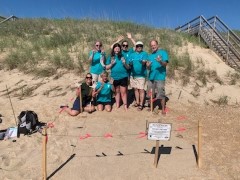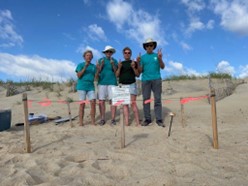By Chris Pruitt
Last year, the first nest was found on June 12. This year it was found Memorial Day weekend, followed closely by a second. As of June 23, we have 12 nests confirmed, vs. only 4 at the same time in 2021. Another unusual thing is the number of false crawls this year, almost as many as there are nests. Frequently, a false crawl is found not too far from a nest. Seems like we have some picky mamas this year. They want that digging area to be just right.
Most of the time, it is easy to identify a false crawl as shown in the picture below. The turtle went down the escarpment and then back up and over to the water, without stopping. Occasionally an area looks like a nest, but after an hour or two of digging no eggs are found. This year we had an “abandoned” nest. As you can see below, there is a 12” deep hole, but that is all. No footprints around it indicate that a person or animal dug it. So, the only conclusion is that the mama started to dig and was scared off by something— human or animal. It is very important to stay way back when observing a nesting turtle. Up until they begin to lay eggs, they can be frightened off.
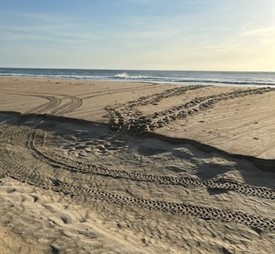
Example of a false crawl.
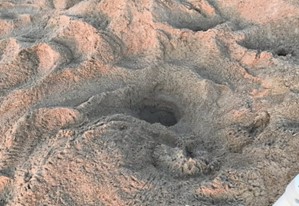
“Abandoned nest”
Of course, nest monitoring cannot be accomplished without our amazing volunteers. ATV drivers hit the beach soon after 5AM, their only thanks being
an occasional nest find and maybe an extraordinary sunrise. This photo is a combination of both. And, an example of a “perfect” find. The crawl is long,
meaning the nest won’t need to be moved; and the body pit and pile of thrown sand are distinct, meaning it should be easy to find eggs to confirm that it is a nest. And it was!
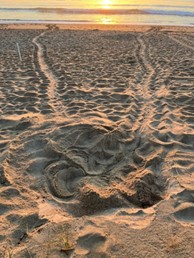
The perfect find – a nest and a beautiful sunrise.
Then there are the diggers. These folks withstand the rising temperatures of the morning to verify the nest and locate the eggs. Sometimes it is not so easy. Like when a nest was recently laid in the 4-wheel drive area. Before the response team could begin to dig, the nest was overrun. Fortunately, a little lump of thrown sand was left to guide the dig. This chance of overrun explains why nests in that area are protected with a larger roped off area.
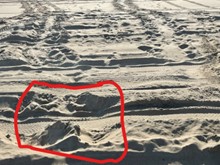
Red marking indicates the nest which had been over run by several vehicles.
Once the eggs have been found, the area is protected by a boundary and a sign explaining the federal penalty for disturbing the nest of an endangered species. Below, volunteers celebrate their work with the traditional nest count high sign.
